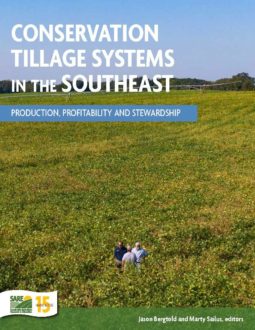“What could be more important to a farmer than soil erosion and soil quality? High-quality soil is a business asset,” says Bob Rawlins, a Georgia farmer who has been using no-till farming for 40 years.
SARE’s newest book, Conservation Tillage Systems in the Southeast, explores the importance of conservation tillage and provides in-depth management guidance to help farmers like Rawlins control erosion and build soil quality. Its emphasis is on the use of conservation tillage in rotations of agronomic crops and cover crops typical of the Southeast.
Download SARE’s Conservation Systems in the Southeast (PDF) or read the online text version.
Rawlins realized the farm needed a change when higher-than-usual amounts of precipitation eroded away his snap beans. He adjusted his production practices to include terracing, strip-till and crop rotation, and the farm has since vastly improved its quality and output of crops. Now, Rawlins is successfully growing watermelon, silage, peanuts and cotton, and soil loss is greatly reduced. “Determination to make no-till work is a key,” says Rawlins. Determination means monitoring the fields, looking for seed placement problems early enough to make adjustments, monitoring to catch weeds early and seeking advice at the first sign of trouble.
Many farmers like Rawlins seek to improve their crop production practices. Conservation Systems in the Southeast addresses the core components of conservation tillage systems and provides specific strategies to help farmers in the southeastern United States incorporate conservation tillage systems into their operations.
For more information:
